Sustainable Operations and Destinations
VerifiedAdded on 2023/01/16
|13
|3472
|74
AI Summary
This article provides an overview of the Sustainable Development Goals (SDGs) and their targets and indicators. It discusses the interconnectedness of the goals and their relation to other global agreements. The article also highlights the barriers to achieving the SDGs and provides recommendations for sustainable development.
Contribute Materials
Your contribution can guide someone’s learning journey. Share your
documents today.
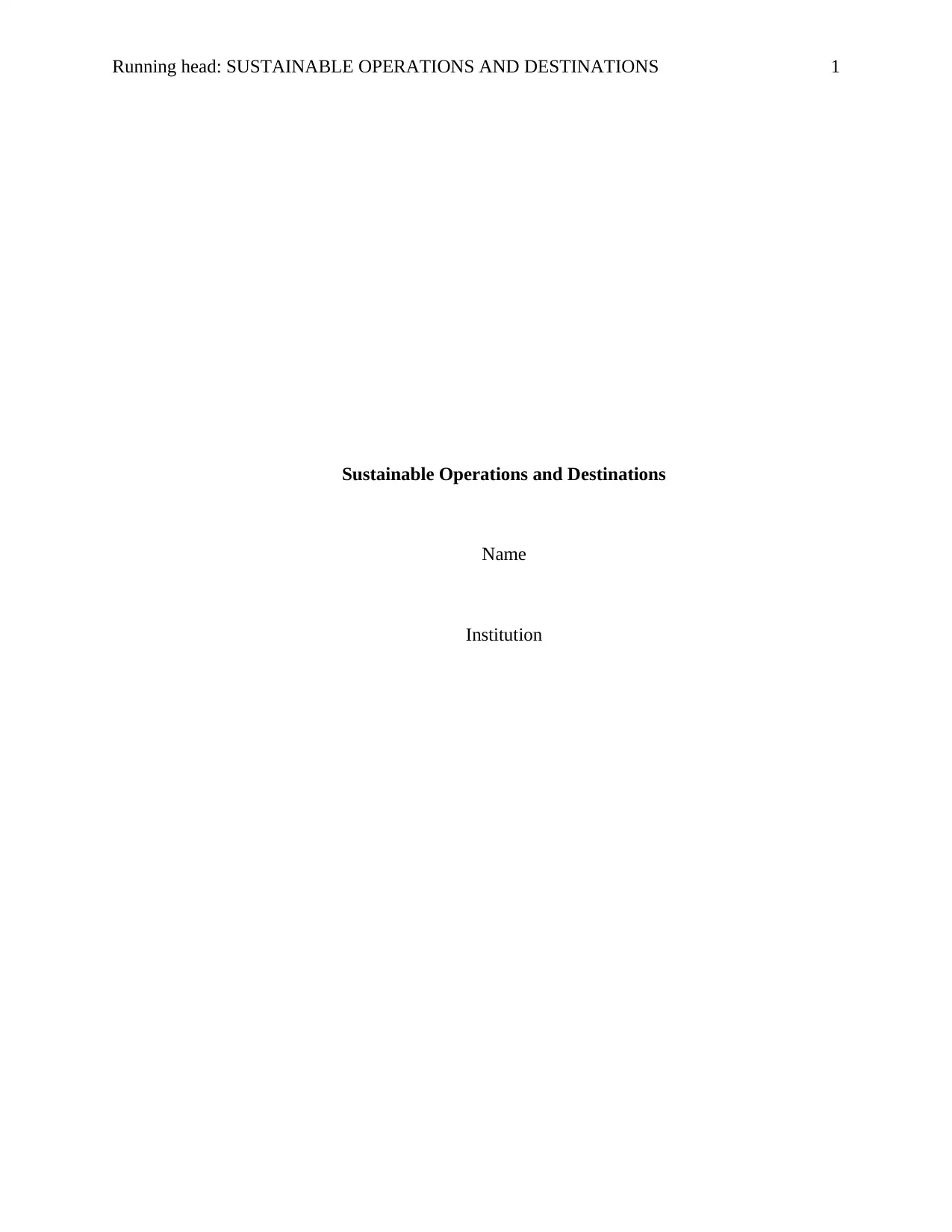
Running head: SUSTAINABLE OPERATIONS AND DESTINATIONS 1
Sustainable Operations and Destinations
Name
Institution
Sustainable Operations and Destinations
Name
Institution
Secure Best Marks with AI Grader
Need help grading? Try our AI Grader for instant feedback on your assignments.
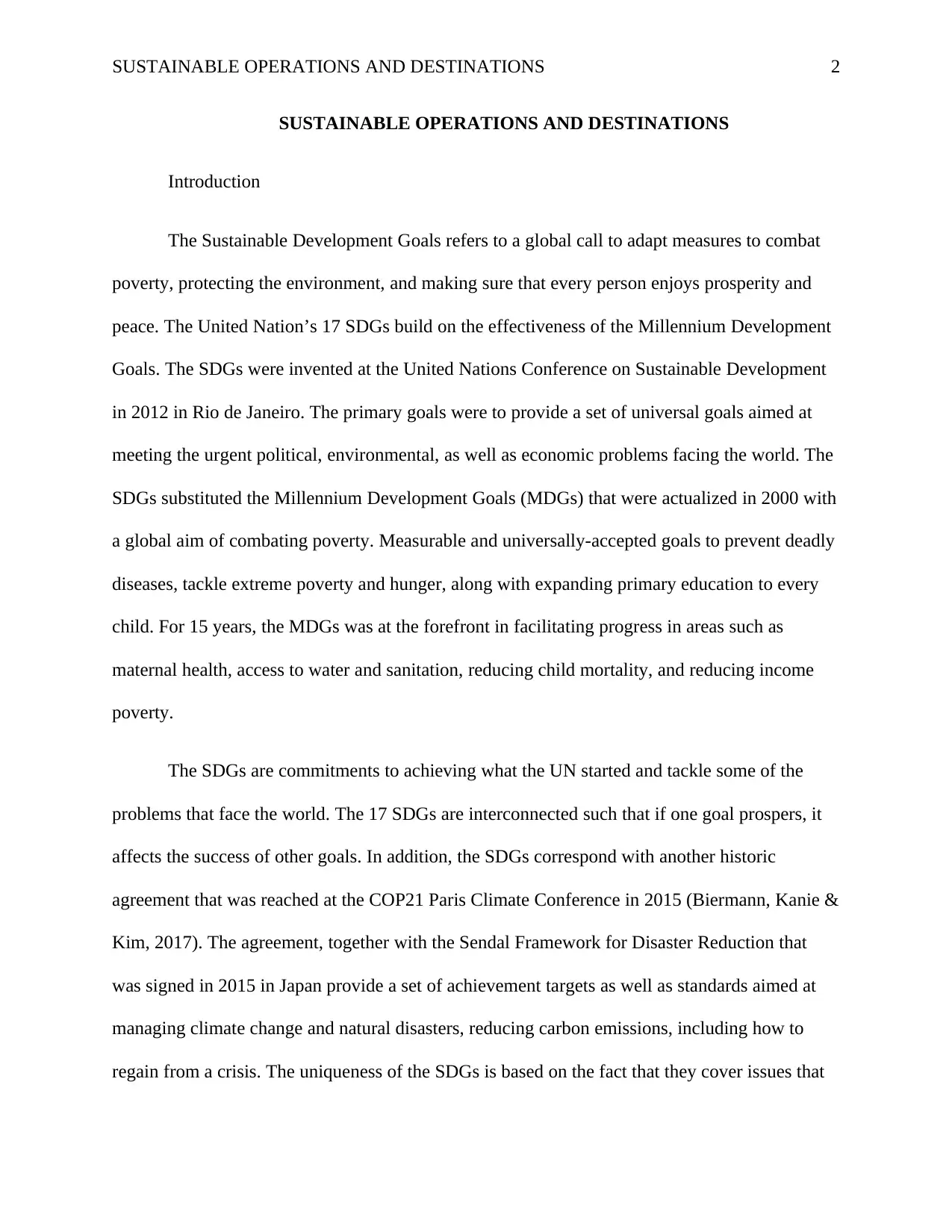
SUSTAINABLE OPERATIONS AND DESTINATIONS 2
SUSTAINABLE OPERATIONS AND DESTINATIONS
Introduction
The Sustainable Development Goals refers to a global call to adapt measures to combat
poverty, protecting the environment, and making sure that every person enjoys prosperity and
peace. The United Nation’s 17 SDGs build on the effectiveness of the Millennium Development
Goals. The SDGs were invented at the United Nations Conference on Sustainable Development
in 2012 in Rio de Janeiro. The primary goals were to provide a set of universal goals aimed at
meeting the urgent political, environmental, as well as economic problems facing the world. The
SDGs substituted the Millennium Development Goals (MDGs) that were actualized in 2000 with
a global aim of combating poverty. Measurable and universally-accepted goals to prevent deadly
diseases, tackle extreme poverty and hunger, along with expanding primary education to every
child. For 15 years, the MDGs was at the forefront in facilitating progress in areas such as
maternal health, access to water and sanitation, reducing child mortality, and reducing income
poverty.
The SDGs are commitments to achieving what the UN started and tackle some of the
problems that face the world. The 17 SDGs are interconnected such that if one goal prospers, it
affects the success of other goals. In addition, the SDGs correspond with another historic
agreement that was reached at the COP21 Paris Climate Conference in 2015 (Biermann, Kanie &
Kim, 2017). The agreement, together with the Sendal Framework for Disaster Reduction that
was signed in 2015 in Japan provide a set of achievement targets as well as standards aimed at
managing climate change and natural disasters, reducing carbon emissions, including how to
regain from a crisis. The uniqueness of the SDGs is based on the fact that they cover issues that
SUSTAINABLE OPERATIONS AND DESTINATIONS
Introduction
The Sustainable Development Goals refers to a global call to adapt measures to combat
poverty, protecting the environment, and making sure that every person enjoys prosperity and
peace. The United Nation’s 17 SDGs build on the effectiveness of the Millennium Development
Goals. The SDGs were invented at the United Nations Conference on Sustainable Development
in 2012 in Rio de Janeiro. The primary goals were to provide a set of universal goals aimed at
meeting the urgent political, environmental, as well as economic problems facing the world. The
SDGs substituted the Millennium Development Goals (MDGs) that were actualized in 2000 with
a global aim of combating poverty. Measurable and universally-accepted goals to prevent deadly
diseases, tackle extreme poverty and hunger, along with expanding primary education to every
child. For 15 years, the MDGs was at the forefront in facilitating progress in areas such as
maternal health, access to water and sanitation, reducing child mortality, and reducing income
poverty.
The SDGs are commitments to achieving what the UN started and tackle some of the
problems that face the world. The 17 SDGs are interconnected such that if one goal prospers, it
affects the success of other goals. In addition, the SDGs correspond with another historic
agreement that was reached at the COP21 Paris Climate Conference in 2015 (Biermann, Kanie &
Kim, 2017). The agreement, together with the Sendal Framework for Disaster Reduction that
was signed in 2015 in Japan provide a set of achievement targets as well as standards aimed at
managing climate change and natural disasters, reducing carbon emissions, including how to
regain from a crisis. The uniqueness of the SDGs is based on the fact that they cover issues that
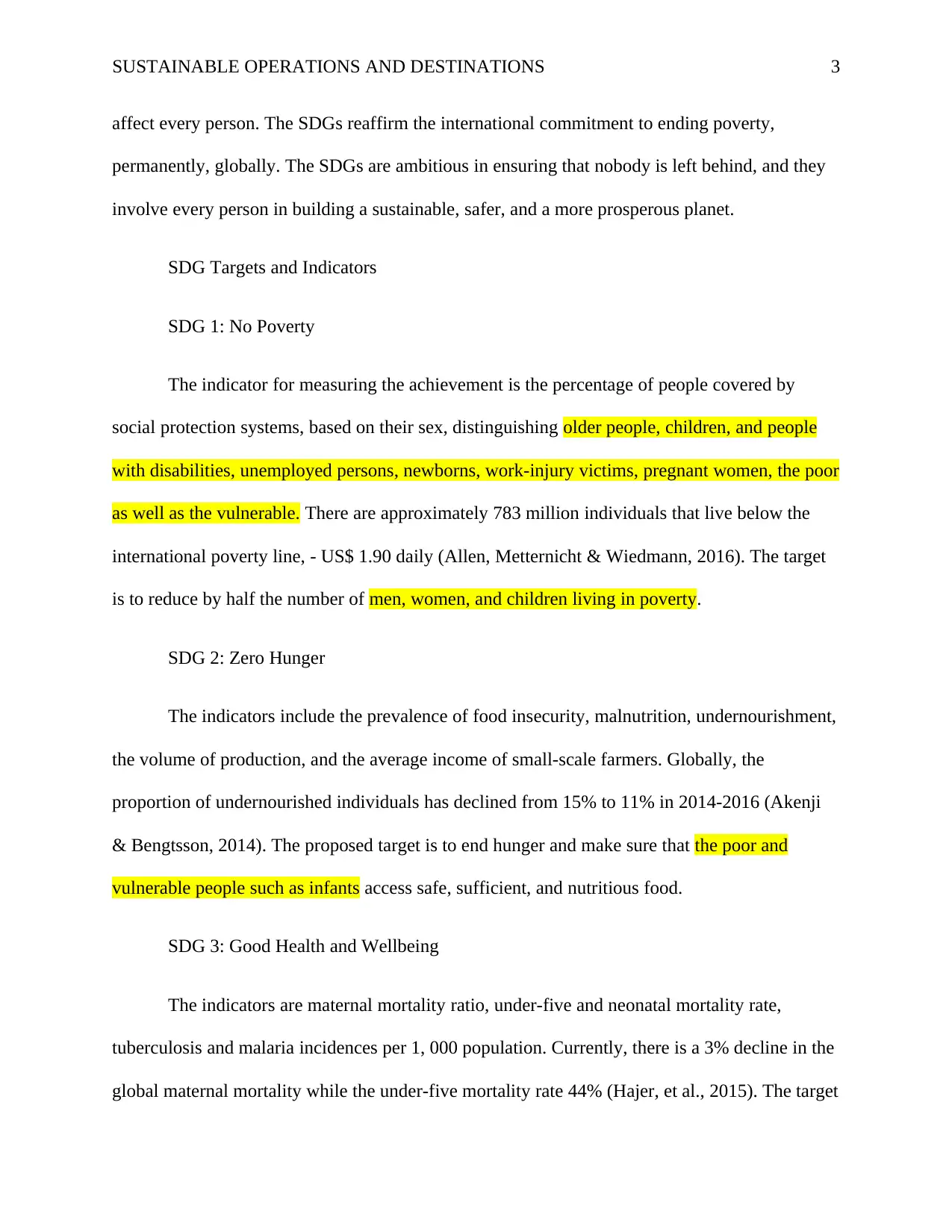
SUSTAINABLE OPERATIONS AND DESTINATIONS 3
affect every person. The SDGs reaffirm the international commitment to ending poverty,
permanently, globally. The SDGs are ambitious in ensuring that nobody is left behind, and they
involve every person in building a sustainable, safer, and a more prosperous planet.
SDG Targets and Indicators
SDG 1: No Poverty
The indicator for measuring the achievement is the percentage of people covered by
social protection systems, based on their sex, distinguishing older people, children, and people
with disabilities, unemployed persons, newborns, work-injury victims, pregnant women, the poor
as well as the vulnerable. There are approximately 783 million individuals that live below the
international poverty line, - US$ 1.90 daily (Allen, Metternicht & Wiedmann, 2016). The target
is to reduce by half the number of men, women, and children living in poverty.
SDG 2: Zero Hunger
The indicators include the prevalence of food insecurity, malnutrition, undernourishment,
the volume of production, and the average income of small-scale farmers. Globally, the
proportion of undernourished individuals has declined from 15% to 11% in 2014-2016 (Akenji
& Bengtsson, 2014). The proposed target is to end hunger and make sure that the poor and
vulnerable people such as infants access safe, sufficient, and nutritious food.
SDG 3: Good Health and Wellbeing
The indicators are maternal mortality ratio, under-five and neonatal mortality rate,
tuberculosis and malaria incidences per 1, 000 population. Currently, there is a 3% decline in the
global maternal mortality while the under-five mortality rate 44% (Hajer, et al., 2015). The target
affect every person. The SDGs reaffirm the international commitment to ending poverty,
permanently, globally. The SDGs are ambitious in ensuring that nobody is left behind, and they
involve every person in building a sustainable, safer, and a more prosperous planet.
SDG Targets and Indicators
SDG 1: No Poverty
The indicator for measuring the achievement is the percentage of people covered by
social protection systems, based on their sex, distinguishing older people, children, and people
with disabilities, unemployed persons, newborns, work-injury victims, pregnant women, the poor
as well as the vulnerable. There are approximately 783 million individuals that live below the
international poverty line, - US$ 1.90 daily (Allen, Metternicht & Wiedmann, 2016). The target
is to reduce by half the number of men, women, and children living in poverty.
SDG 2: Zero Hunger
The indicators include the prevalence of food insecurity, malnutrition, undernourishment,
the volume of production, and the average income of small-scale farmers. Globally, the
proportion of undernourished individuals has declined from 15% to 11% in 2014-2016 (Akenji
& Bengtsson, 2014). The proposed target is to end hunger and make sure that the poor and
vulnerable people such as infants access safe, sufficient, and nutritious food.
SDG 3: Good Health and Wellbeing
The indicators are maternal mortality ratio, under-five and neonatal mortality rate,
tuberculosis and malaria incidences per 1, 000 population. Currently, there is a 3% decline in the
global maternal mortality while the under-five mortality rate 44% (Hajer, et al., 2015). The target

SUSTAINABLE OPERATIONS AND DESTINATIONS 4
is reducing the global mortality ratio below 70 per 1, 000 and prevent under-five mortality below
25 per 1,000 live births and neonatal mortality below 12 per 1000 live births.
SDG 4: Quality Education
The indicators include the rates of primary and secondary completion for girls and boys,
Early Child Development Index (ECDI), and tertiary enrollment rates for men and women. Since
2008, the rate of primary school age children not going to school is at 9% (Costanza, Fioramonti
& Kubiszewski, 2016). In developing regions, the enrollment for quality education has reached
91%. By 2030, the UN aims to lower the rates of school leaving below 10% as well as make sure
that approximately 40% of 30-34-year-old individuals complete higher education.
SDG 5: Gender Equality
The target indicators include the number of women and girls aged 15-49 that have
undergone FGM, percentage of women aged 20-24 that were married before age 15-18 years,
whether or not there exist legal frameworks to enforce, monitor, and promote non-
discrimination, and equality on the basis of sex. Current statics show that approximately 21% of
women aged 20-24 years were married before they had attained the age 18 (Fukuda, 2016). One
of three girls has undergone genital mutilation. The target statistic is to eliminate disparity in all
education levels, physical and sexual violence, and wage discrimination, among others.
SDG 6: Clean Water and Sanitation
The indicators include promoting the population by safely managing drinking water
services, the proportion of safely treated wastewater, the number of people using safely managed
sanitation services, and the change of water-use efficiency. 29% lack safely managed drinking
is reducing the global mortality ratio below 70 per 1, 000 and prevent under-five mortality below
25 per 1,000 live births and neonatal mortality below 12 per 1000 live births.
SDG 4: Quality Education
The indicators include the rates of primary and secondary completion for girls and boys,
Early Child Development Index (ECDI), and tertiary enrollment rates for men and women. Since
2008, the rate of primary school age children not going to school is at 9% (Costanza, Fioramonti
& Kubiszewski, 2016). In developing regions, the enrollment for quality education has reached
91%. By 2030, the UN aims to lower the rates of school leaving below 10% as well as make sure
that approximately 40% of 30-34-year-old individuals complete higher education.
SDG 5: Gender Equality
The target indicators include the number of women and girls aged 15-49 that have
undergone FGM, percentage of women aged 20-24 that were married before age 15-18 years,
whether or not there exist legal frameworks to enforce, monitor, and promote non-
discrimination, and equality on the basis of sex. Current statics show that approximately 21% of
women aged 20-24 years were married before they had attained the age 18 (Fukuda, 2016). One
of three girls has undergone genital mutilation. The target statistic is to eliminate disparity in all
education levels, physical and sexual violence, and wage discrimination, among others.
SDG 6: Clean Water and Sanitation
The indicators include promoting the population by safely managing drinking water
services, the proportion of safely treated wastewater, the number of people using safely managed
sanitation services, and the change of water-use efficiency. 29% lack safely managed drinking
Secure Best Marks with AI Grader
Need help grading? Try our AI Grader for instant feedback on your assignments.
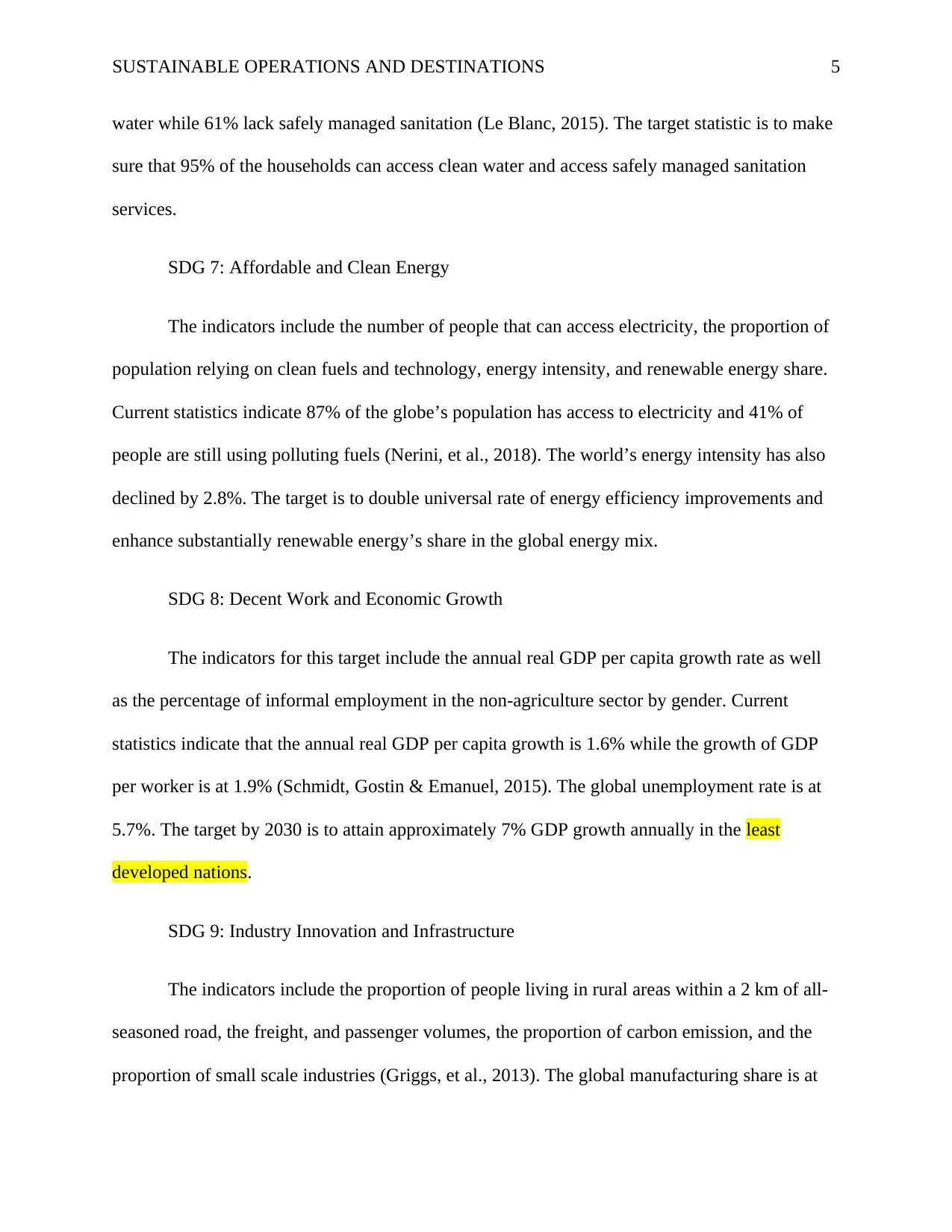
SUSTAINABLE OPERATIONS AND DESTINATIONS 5
water while 61% lack safely managed sanitation (Le Blanc, 2015). The target statistic is to make
sure that 95% of the households can access clean water and access safely managed sanitation
services.
SDG 7: Affordable and Clean Energy
The indicators include the number of people that can access electricity, the proportion of
population relying on clean fuels and technology, energy intensity, and renewable energy share.
Current statistics indicate 87% of the globe’s population has access to electricity and 41% of
people are still using polluting fuels (Nerini, et al., 2018). The world’s energy intensity has also
declined by 2.8%. The target is to double universal rate of energy efficiency improvements and
enhance substantially renewable energy’s share in the global energy mix.
SDG 8: Decent Work and Economic Growth
The indicators for this target include the annual real GDP per capita growth rate as well
as the percentage of informal employment in the non-agriculture sector by gender. Current
statistics indicate that the annual real GDP per capita growth is 1.6% while the growth of GDP
per worker is at 1.9% (Schmidt, Gostin & Emanuel, 2015). The global unemployment rate is at
5.7%. The target by 2030 is to attain approximately 7% GDP growth annually in the least
developed nations.
SDG 9: Industry Innovation and Infrastructure
The indicators include the proportion of people living in rural areas within a 2 km of all-
seasoned road, the freight, and passenger volumes, the proportion of carbon emission, and the
proportion of small scale industries (Griggs, et al., 2013). The global manufacturing share is at
water while 61% lack safely managed sanitation (Le Blanc, 2015). The target statistic is to make
sure that 95% of the households can access clean water and access safely managed sanitation
services.
SDG 7: Affordable and Clean Energy
The indicators include the number of people that can access electricity, the proportion of
population relying on clean fuels and technology, energy intensity, and renewable energy share.
Current statistics indicate 87% of the globe’s population has access to electricity and 41% of
people are still using polluting fuels (Nerini, et al., 2018). The world’s energy intensity has also
declined by 2.8%. The target is to double universal rate of energy efficiency improvements and
enhance substantially renewable energy’s share in the global energy mix.
SDG 8: Decent Work and Economic Growth
The indicators for this target include the annual real GDP per capita growth rate as well
as the percentage of informal employment in the non-agriculture sector by gender. Current
statistics indicate that the annual real GDP per capita growth is 1.6% while the growth of GDP
per worker is at 1.9% (Schmidt, Gostin & Emanuel, 2015). The global unemployment rate is at
5.7%. The target by 2030 is to attain approximately 7% GDP growth annually in the least
developed nations.
SDG 9: Industry Innovation and Infrastructure
The indicators include the proportion of people living in rural areas within a 2 km of all-
seasoned road, the freight, and passenger volumes, the proportion of carbon emission, and the
proportion of small scale industries (Griggs, et al., 2013). The global manufacturing share is at
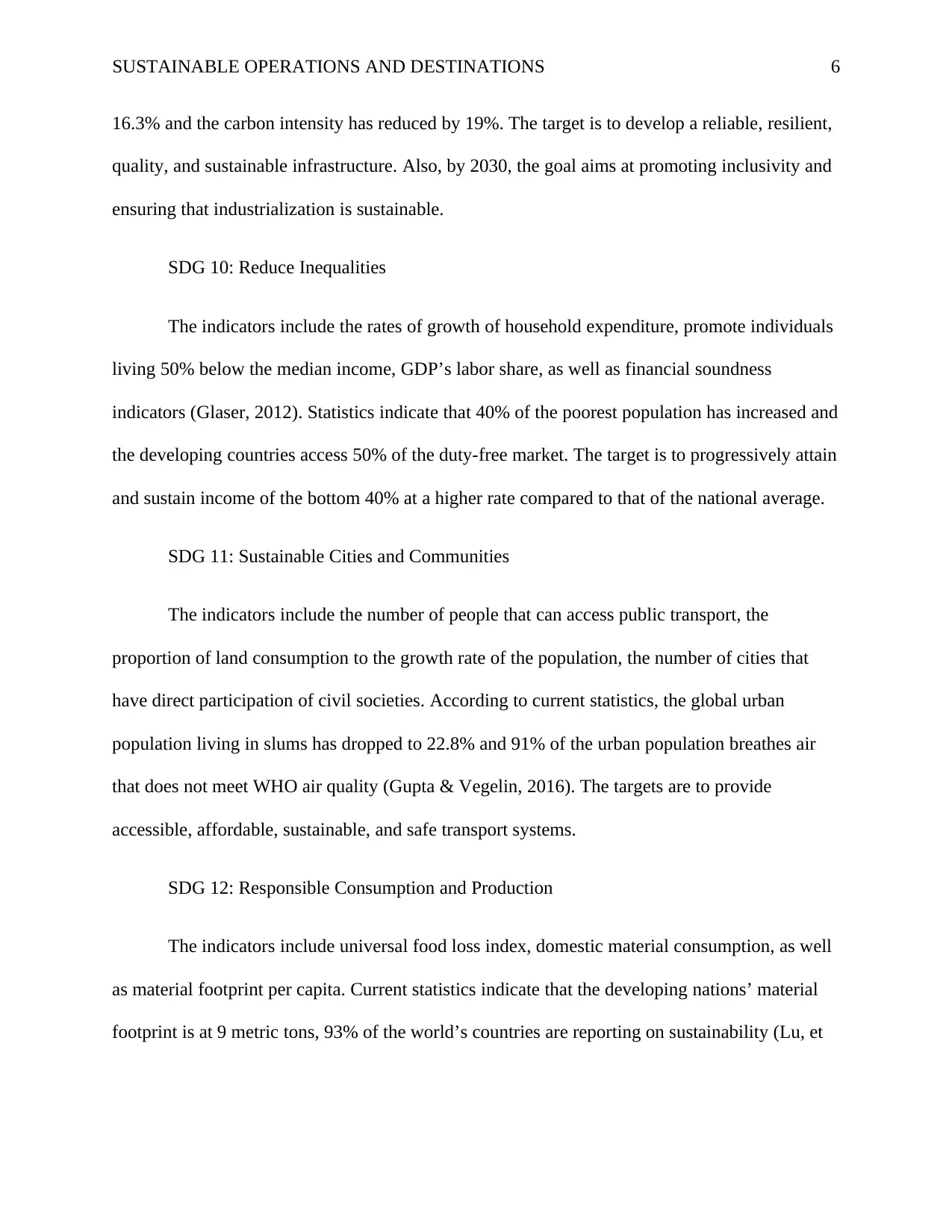
SUSTAINABLE OPERATIONS AND DESTINATIONS 6
16.3% and the carbon intensity has reduced by 19%. The target is to develop a reliable, resilient,
quality, and sustainable infrastructure. Also, by 2030, the goal aims at promoting inclusivity and
ensuring that industrialization is sustainable.
SDG 10: Reduce Inequalities
The indicators include the rates of growth of household expenditure, promote individuals
living 50% below the median income, GDP’s labor share, as well as financial soundness
indicators (Glaser, 2012). Statistics indicate that 40% of the poorest population has increased and
the developing countries access 50% of the duty-free market. The target is to progressively attain
and sustain income of the bottom 40% at a higher rate compared to that of the national average.
SDG 11: Sustainable Cities and Communities
The indicators include the number of people that can access public transport, the
proportion of land consumption to the growth rate of the population, the number of cities that
have direct participation of civil societies. According to current statistics, the global urban
population living in slums has dropped to 22.8% and 91% of the urban population breathes air
that does not meet WHO air quality (Gupta & Vegelin, 2016). The targets are to provide
accessible, affordable, sustainable, and safe transport systems.
SDG 12: Responsible Consumption and Production
The indicators include universal food loss index, domestic material consumption, as well
as material footprint per capita. Current statistics indicate that the developing nations’ material
footprint is at 9 metric tons, 93% of the world’s countries are reporting on sustainability (Lu, et
16.3% and the carbon intensity has reduced by 19%. The target is to develop a reliable, resilient,
quality, and sustainable infrastructure. Also, by 2030, the goal aims at promoting inclusivity and
ensuring that industrialization is sustainable.
SDG 10: Reduce Inequalities
The indicators include the rates of growth of household expenditure, promote individuals
living 50% below the median income, GDP’s labor share, as well as financial soundness
indicators (Glaser, 2012). Statistics indicate that 40% of the poorest population has increased and
the developing countries access 50% of the duty-free market. The target is to progressively attain
and sustain income of the bottom 40% at a higher rate compared to that of the national average.
SDG 11: Sustainable Cities and Communities
The indicators include the number of people that can access public transport, the
proportion of land consumption to the growth rate of the population, the number of cities that
have direct participation of civil societies. According to current statistics, the global urban
population living in slums has dropped to 22.8% and 91% of the urban population breathes air
that does not meet WHO air quality (Gupta & Vegelin, 2016). The targets are to provide
accessible, affordable, sustainable, and safe transport systems.
SDG 12: Responsible Consumption and Production
The indicators include universal food loss index, domestic material consumption, as well
as material footprint per capita. Current statistics indicate that the developing nations’ material
footprint is at 9 metric tons, 93% of the world’s countries are reporting on sustainability (Lu, et

SUSTAINABLE OPERATIONS AND DESTINATIONS 7
al., 2015). The target is to attain sustainable management as well as efficiently using natural
resources, reducing waste generation by through reduction, reuse, prevention, and recycling.
SDG 13: Climate Action
The indicators include the number of states having local and national disaster risk
mitigation strategies, death rate, including the number of individuals that are affected by the
disaster. According to current statistics, 10 developing nations have adapted and responded to
climate change, and 175 countries had ratified the Paris Agreement (Pradhan, et al., 2017). The
targets include integrating the climate change measure into national strategies, policies, and
planning as well as improving awareness on strategies to mitigate climate change.
SDG 14: Life below Water
Some of the indicators include coastal eutrophication index as well as the density of
floating plastic debris, the index of fish stocks that are within sustainable levels, the average
marine acidity, and the amount of research budget set aside for research in marine technology.
According to current statistics, the share of fish stocks that are within biologically sustainable
levels is at 69% and marine acidity has raised by at least 26% (Sachs, 2012). The goal aims at
conserving approximately 10% of coastal along with marine areas.
SDG 15: Life on Land
Some indicators include the red list index, mountain green cover index, forest area,
proportion of trafficked wildlife, and proportion of degraded land. Statistics indicate that forests
are home to 80% animals, plants, and insects and land degradation has affected almost 1.5 billion
people (Keesstra, et al., 2016). In addition, the loss of arable land is estimated at 35 times the
al., 2015). The target is to attain sustainable management as well as efficiently using natural
resources, reducing waste generation by through reduction, reuse, prevention, and recycling.
SDG 13: Climate Action
The indicators include the number of states having local and national disaster risk
mitigation strategies, death rate, including the number of individuals that are affected by the
disaster. According to current statistics, 10 developing nations have adapted and responded to
climate change, and 175 countries had ratified the Paris Agreement (Pradhan, et al., 2017). The
targets include integrating the climate change measure into national strategies, policies, and
planning as well as improving awareness on strategies to mitigate climate change.
SDG 14: Life below Water
Some of the indicators include coastal eutrophication index as well as the density of
floating plastic debris, the index of fish stocks that are within sustainable levels, the average
marine acidity, and the amount of research budget set aside for research in marine technology.
According to current statistics, the share of fish stocks that are within biologically sustainable
levels is at 69% and marine acidity has raised by at least 26% (Sachs, 2012). The goal aims at
conserving approximately 10% of coastal along with marine areas.
SDG 15: Life on Land
Some indicators include the red list index, mountain green cover index, forest area,
proportion of trafficked wildlife, and proportion of degraded land. Statistics indicate that forests
are home to 80% animals, plants, and insects and land degradation has affected almost 1.5 billion
people (Keesstra, et al., 2016). In addition, the loss of arable land is estimated at 35 times the
Paraphrase This Document
Need a fresh take? Get an instant paraphrase of this document with our AI Paraphraser
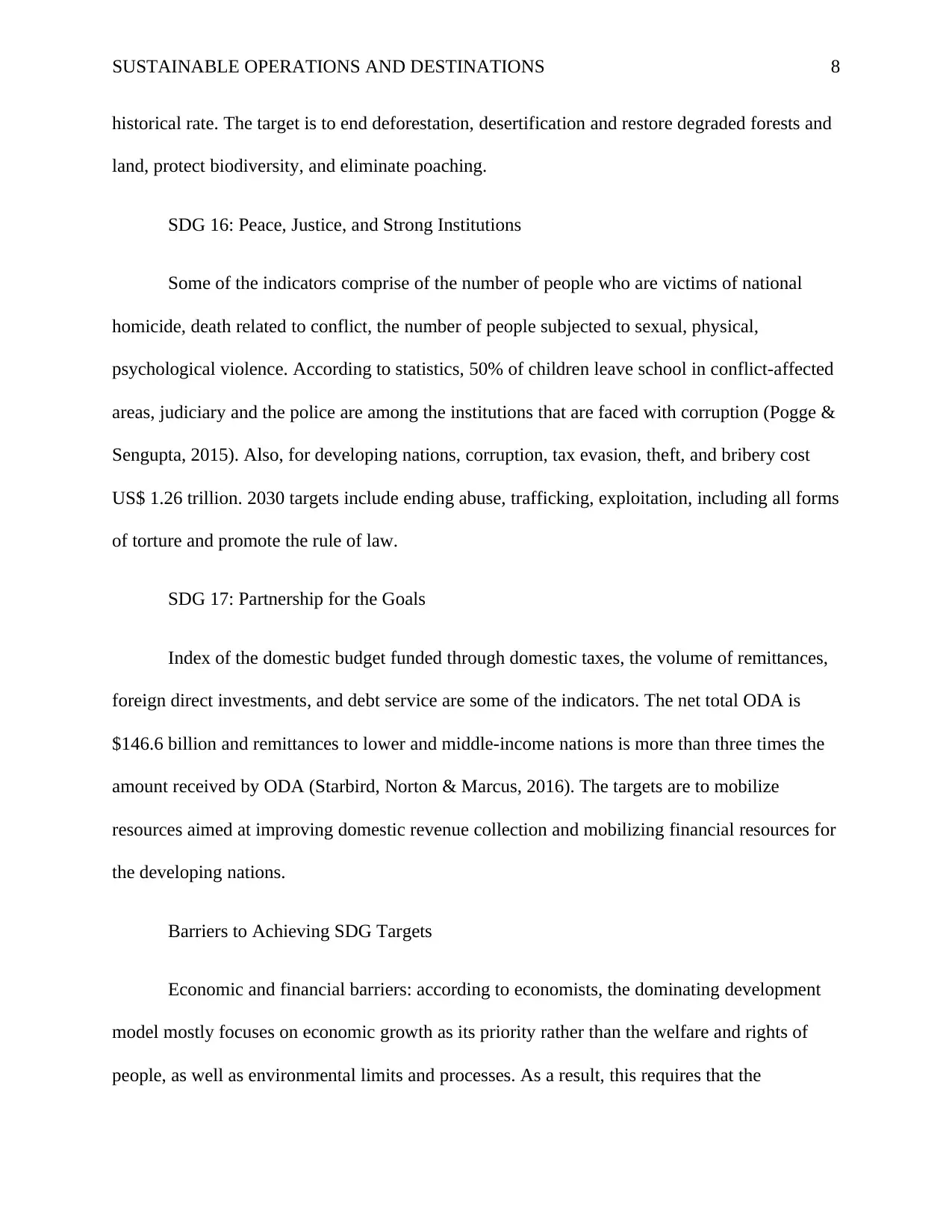
SUSTAINABLE OPERATIONS AND DESTINATIONS 8
historical rate. The target is to end deforestation, desertification and restore degraded forests and
land, protect biodiversity, and eliminate poaching.
SDG 16: Peace, Justice, and Strong Institutions
Some of the indicators comprise of the number of people who are victims of national
homicide, death related to conflict, the number of people subjected to sexual, physical,
psychological violence. According to statistics, 50% of children leave school in conflict-affected
areas, judiciary and the police are among the institutions that are faced with corruption (Pogge &
Sengupta, 2015). Also, for developing nations, corruption, tax evasion, theft, and bribery cost
US$ 1.26 trillion. 2030 targets include ending abuse, trafficking, exploitation, including all forms
of torture and promote the rule of law.
SDG 17: Partnership for the Goals
Index of the domestic budget funded through domestic taxes, the volume of remittances,
foreign direct investments, and debt service are some of the indicators. The net total ODA is
$146.6 billion and remittances to lower and middle-income nations is more than three times the
amount received by ODA (Starbird, Norton & Marcus, 2016). The targets are to mobilize
resources aimed at improving domestic revenue collection and mobilizing financial resources for
the developing nations.
Barriers to Achieving SDG Targets
Economic and financial barriers: according to economists, the dominating development
model mostly focuses on economic growth as its priority rather than the welfare and rights of
people, as well as environmental limits and processes. As a result, this requires that the
historical rate. The target is to end deforestation, desertification and restore degraded forests and
land, protect biodiversity, and eliminate poaching.
SDG 16: Peace, Justice, and Strong Institutions
Some of the indicators comprise of the number of people who are victims of national
homicide, death related to conflict, the number of people subjected to sexual, physical,
psychological violence. According to statistics, 50% of children leave school in conflict-affected
areas, judiciary and the police are among the institutions that are faced with corruption (Pogge &
Sengupta, 2015). Also, for developing nations, corruption, tax evasion, theft, and bribery cost
US$ 1.26 trillion. 2030 targets include ending abuse, trafficking, exploitation, including all forms
of torture and promote the rule of law.
SDG 17: Partnership for the Goals
Index of the domestic budget funded through domestic taxes, the volume of remittances,
foreign direct investments, and debt service are some of the indicators. The net total ODA is
$146.6 billion and remittances to lower and middle-income nations is more than three times the
amount received by ODA (Starbird, Norton & Marcus, 2016). The targets are to mobilize
resources aimed at improving domestic revenue collection and mobilizing financial resources for
the developing nations.
Barriers to Achieving SDG Targets
Economic and financial barriers: according to economists, the dominating development
model mostly focuses on economic growth as its priority rather than the welfare and rights of
people, as well as environmental limits and processes. As a result, this requires that the

SUSTAINABLE OPERATIONS AND DESTINATIONS 9
worldview shifts from treating the environment as part of the economy and treat the economy as
part of the environment. Strategically, this shows that environmental services can only be
maintained if the economy is adapted.
Innovation barriers: there lacks innovation-oriented research in the educational sector.
As such, a closer connection has to be established between the economy and research institutes,
thus overcoming the challenge of transferring knowledge to real-life applications.
Political barriers: the major challenges in achieving the targets are inadequate economic,
environmental as well as social methods for policies, projects, and plans.
Institutional barriers: these barriers are due to lack of institutional experience in operating
all mechanisms associated with the democratic system that has been frustrating and hindering
sustainable developments among many developing nations.
Social barriers: the biggest social barriers in attaining the targets are population growth
including the unsustainable consumption and production patterns among the rich. Other barriers
include marginalization of the poor, insufficient incentives, inadequate interaction between the
civil society and the government, and limited awareness on sustainable development
Recommendations
All 17 items are most likely are not 100% achievable as nothing is. However, I believe a
very high percentage of each item is attainable. What keeps this from 100% achievability is the
fact that no governing body including the UN, can get all countries to agree on anything
including promising and fulfilling these 17 items completely or some of them at all. Some
recommendations that the UN can adopt include:
worldview shifts from treating the environment as part of the economy and treat the economy as
part of the environment. Strategically, this shows that environmental services can only be
maintained if the economy is adapted.
Innovation barriers: there lacks innovation-oriented research in the educational sector.
As such, a closer connection has to be established between the economy and research institutes,
thus overcoming the challenge of transferring knowledge to real-life applications.
Political barriers: the major challenges in achieving the targets are inadequate economic,
environmental as well as social methods for policies, projects, and plans.
Institutional barriers: these barriers are due to lack of institutional experience in operating
all mechanisms associated with the democratic system that has been frustrating and hindering
sustainable developments among many developing nations.
Social barriers: the biggest social barriers in attaining the targets are population growth
including the unsustainable consumption and production patterns among the rich. Other barriers
include marginalization of the poor, insufficient incentives, inadequate interaction between the
civil society and the government, and limited awareness on sustainable development
Recommendations
All 17 items are most likely are not 100% achievable as nothing is. However, I believe a
very high percentage of each item is attainable. What keeps this from 100% achievability is the
fact that no governing body including the UN, can get all countries to agree on anything
including promising and fulfilling these 17 items completely or some of them at all. Some
recommendations that the UN can adopt include:
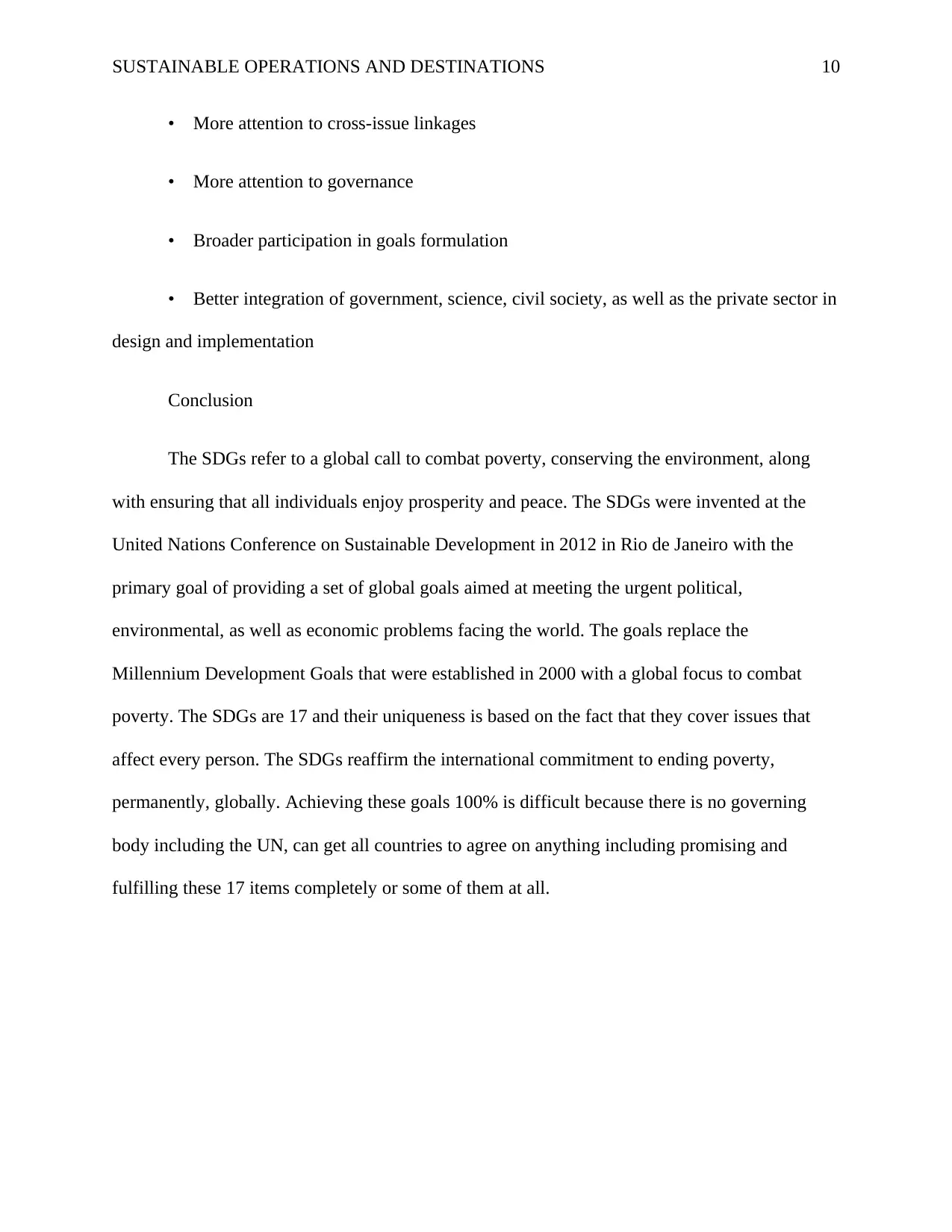
SUSTAINABLE OPERATIONS AND DESTINATIONS 10
• More attention to cross-issue linkages
• More attention to governance
• Broader participation in goals formulation
• Better integration of government, science, civil society, as well as the private sector in
design and implementation
Conclusion
The SDGs refer to a global call to combat poverty, conserving the environment, along
with ensuring that all individuals enjoy prosperity and peace. The SDGs were invented at the
United Nations Conference on Sustainable Development in 2012 in Rio de Janeiro with the
primary goal of providing a set of global goals aimed at meeting the urgent political,
environmental, as well as economic problems facing the world. The goals replace the
Millennium Development Goals that were established in 2000 with a global focus to combat
poverty. The SDGs are 17 and their uniqueness is based on the fact that they cover issues that
affect every person. The SDGs reaffirm the international commitment to ending poverty,
permanently, globally. Achieving these goals 100% is difficult because there is no governing
body including the UN, can get all countries to agree on anything including promising and
fulfilling these 17 items completely or some of them at all.
• More attention to cross-issue linkages
• More attention to governance
• Broader participation in goals formulation
• Better integration of government, science, civil society, as well as the private sector in
design and implementation
Conclusion
The SDGs refer to a global call to combat poverty, conserving the environment, along
with ensuring that all individuals enjoy prosperity and peace. The SDGs were invented at the
United Nations Conference on Sustainable Development in 2012 in Rio de Janeiro with the
primary goal of providing a set of global goals aimed at meeting the urgent political,
environmental, as well as economic problems facing the world. The goals replace the
Millennium Development Goals that were established in 2000 with a global focus to combat
poverty. The SDGs are 17 and their uniqueness is based on the fact that they cover issues that
affect every person. The SDGs reaffirm the international commitment to ending poverty,
permanently, globally. Achieving these goals 100% is difficult because there is no governing
body including the UN, can get all countries to agree on anything including promising and
fulfilling these 17 items completely or some of them at all.
Secure Best Marks with AI Grader
Need help grading? Try our AI Grader for instant feedback on your assignments.
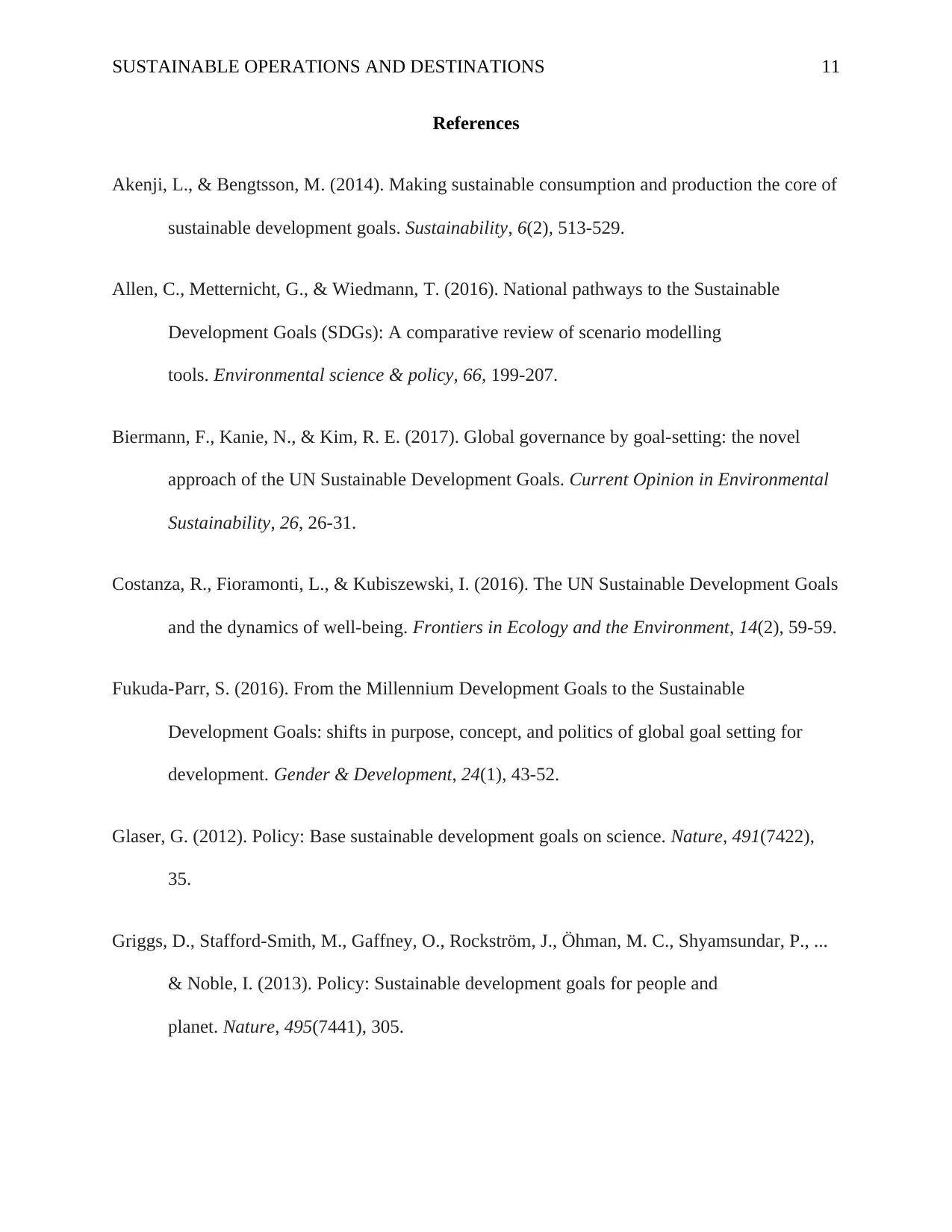
SUSTAINABLE OPERATIONS AND DESTINATIONS 11
References
Akenji, L., & Bengtsson, M. (2014). Making sustainable consumption and production the core of
sustainable development goals. Sustainability, 6(2), 513-529.
Allen, C., Metternicht, G., & Wiedmann, T. (2016). National pathways to the Sustainable
Development Goals (SDGs): A comparative review of scenario modelling
tools. Environmental science & policy, 66, 199-207.
Biermann, F., Kanie, N., & Kim, R. E. (2017). Global governance by goal-setting: the novel
approach of the UN Sustainable Development Goals. Current Opinion in Environmental
Sustainability, 26, 26-31.
Costanza, R., Fioramonti, L., & Kubiszewski, I. (2016). The UN Sustainable Development Goals
and the dynamics of well-being. Frontiers in Ecology and the Environment, 14(2), 59-59.
Fukuda-Parr, S. (2016). From the Millennium Development Goals to the Sustainable
Development Goals: shifts in purpose, concept, and politics of global goal setting for
development. Gender & Development, 24(1), 43-52.
Glaser, G. (2012). Policy: Base sustainable development goals on science. Nature, 491(7422),
35.
Griggs, D., Stafford-Smith, M., Gaffney, O., Rockström, J., Öhman, M. C., Shyamsundar, P., ...
& Noble, I. (2013). Policy: Sustainable development goals for people and
planet. Nature, 495(7441), 305.
References
Akenji, L., & Bengtsson, M. (2014). Making sustainable consumption and production the core of
sustainable development goals. Sustainability, 6(2), 513-529.
Allen, C., Metternicht, G., & Wiedmann, T. (2016). National pathways to the Sustainable
Development Goals (SDGs): A comparative review of scenario modelling
tools. Environmental science & policy, 66, 199-207.
Biermann, F., Kanie, N., & Kim, R. E. (2017). Global governance by goal-setting: the novel
approach of the UN Sustainable Development Goals. Current Opinion in Environmental
Sustainability, 26, 26-31.
Costanza, R., Fioramonti, L., & Kubiszewski, I. (2016). The UN Sustainable Development Goals
and the dynamics of well-being. Frontiers in Ecology and the Environment, 14(2), 59-59.
Fukuda-Parr, S. (2016). From the Millennium Development Goals to the Sustainable
Development Goals: shifts in purpose, concept, and politics of global goal setting for
development. Gender & Development, 24(1), 43-52.
Glaser, G. (2012). Policy: Base sustainable development goals on science. Nature, 491(7422),
35.
Griggs, D., Stafford-Smith, M., Gaffney, O., Rockström, J., Öhman, M. C., Shyamsundar, P., ...
& Noble, I. (2013). Policy: Sustainable development goals for people and
planet. Nature, 495(7441), 305.
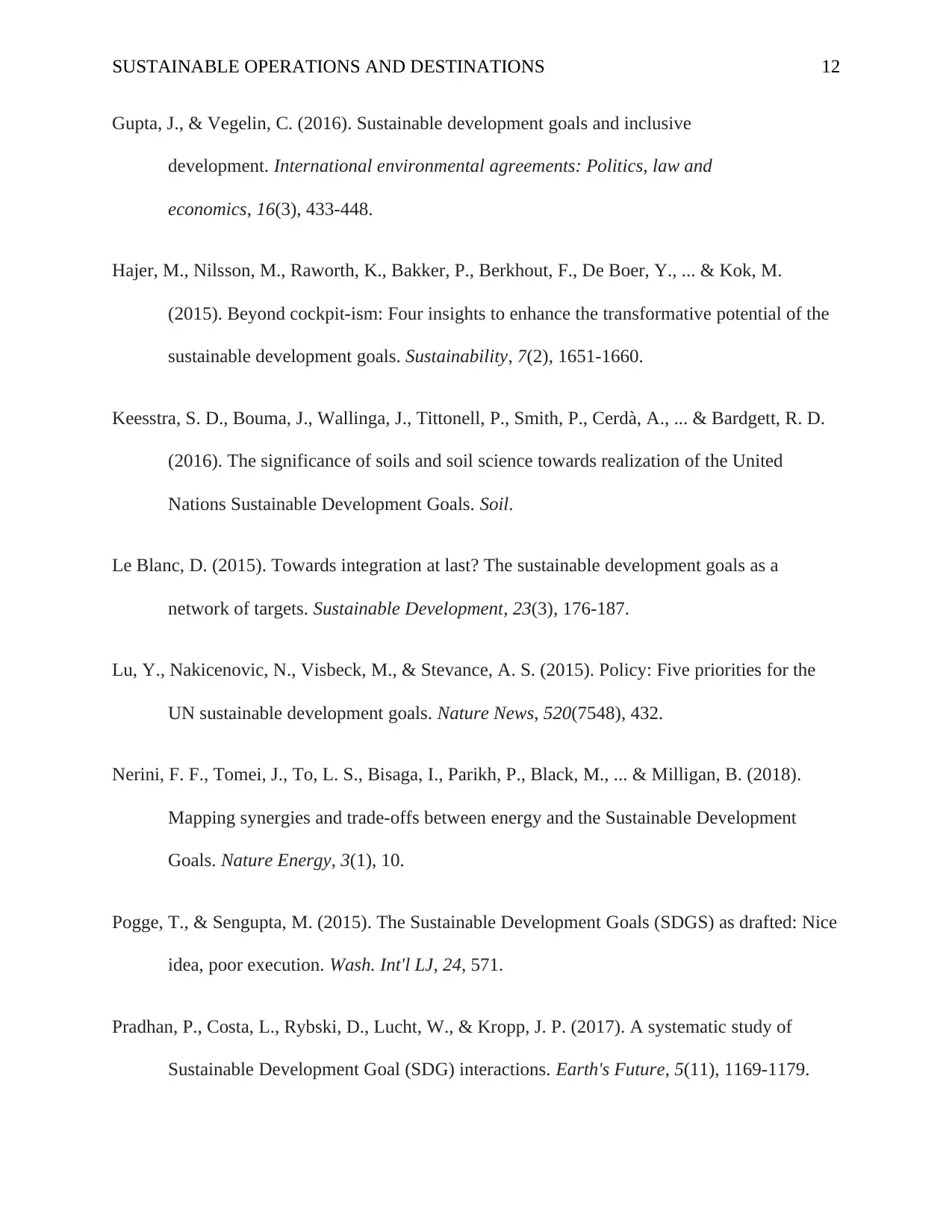
SUSTAINABLE OPERATIONS AND DESTINATIONS 12
Gupta, J., & Vegelin, C. (2016). Sustainable development goals and inclusive
development. International environmental agreements: Politics, law and
economics, 16(3), 433-448.
Hajer, M., Nilsson, M., Raworth, K., Bakker, P., Berkhout, F., De Boer, Y., ... & Kok, M.
(2015). Beyond cockpit-ism: Four insights to enhance the transformative potential of the
sustainable development goals. Sustainability, 7(2), 1651-1660.
Keesstra, S. D., Bouma, J., Wallinga, J., Tittonell, P., Smith, P., Cerdà, A., ... & Bardgett, R. D.
(2016). The significance of soils and soil science towards realization of the United
Nations Sustainable Development Goals. Soil.
Le Blanc, D. (2015). Towards integration at last? The sustainable development goals as a
network of targets. Sustainable Development, 23(3), 176-187.
Lu, Y., Nakicenovic, N., Visbeck, M., & Stevance, A. S. (2015). Policy: Five priorities for the
UN sustainable development goals. Nature News, 520(7548), 432.
Nerini, F. F., Tomei, J., To, L. S., Bisaga, I., Parikh, P., Black, M., ... & Milligan, B. (2018).
Mapping synergies and trade-offs between energy and the Sustainable Development
Goals. Nature Energy, 3(1), 10.
Pogge, T., & Sengupta, M. (2015). The Sustainable Development Goals (SDGS) as drafted: Nice
idea, poor execution. Wash. Int'l LJ, 24, 571.
Pradhan, P., Costa, L., Rybski, D., Lucht, W., & Kropp, J. P. (2017). A systematic study of
Sustainable Development Goal (SDG) interactions. Earth's Future, 5(11), 1169-1179.
Gupta, J., & Vegelin, C. (2016). Sustainable development goals and inclusive
development. International environmental agreements: Politics, law and
economics, 16(3), 433-448.
Hajer, M., Nilsson, M., Raworth, K., Bakker, P., Berkhout, F., De Boer, Y., ... & Kok, M.
(2015). Beyond cockpit-ism: Four insights to enhance the transformative potential of the
sustainable development goals. Sustainability, 7(2), 1651-1660.
Keesstra, S. D., Bouma, J., Wallinga, J., Tittonell, P., Smith, P., Cerdà, A., ... & Bardgett, R. D.
(2016). The significance of soils and soil science towards realization of the United
Nations Sustainable Development Goals. Soil.
Le Blanc, D. (2015). Towards integration at last? The sustainable development goals as a
network of targets. Sustainable Development, 23(3), 176-187.
Lu, Y., Nakicenovic, N., Visbeck, M., & Stevance, A. S. (2015). Policy: Five priorities for the
UN sustainable development goals. Nature News, 520(7548), 432.
Nerini, F. F., Tomei, J., To, L. S., Bisaga, I., Parikh, P., Black, M., ... & Milligan, B. (2018).
Mapping synergies and trade-offs between energy and the Sustainable Development
Goals. Nature Energy, 3(1), 10.
Pogge, T., & Sengupta, M. (2015). The Sustainable Development Goals (SDGS) as drafted: Nice
idea, poor execution. Wash. Int'l LJ, 24, 571.
Pradhan, P., Costa, L., Rybski, D., Lucht, W., & Kropp, J. P. (2017). A systematic study of
Sustainable Development Goal (SDG) interactions. Earth's Future, 5(11), 1169-1179.
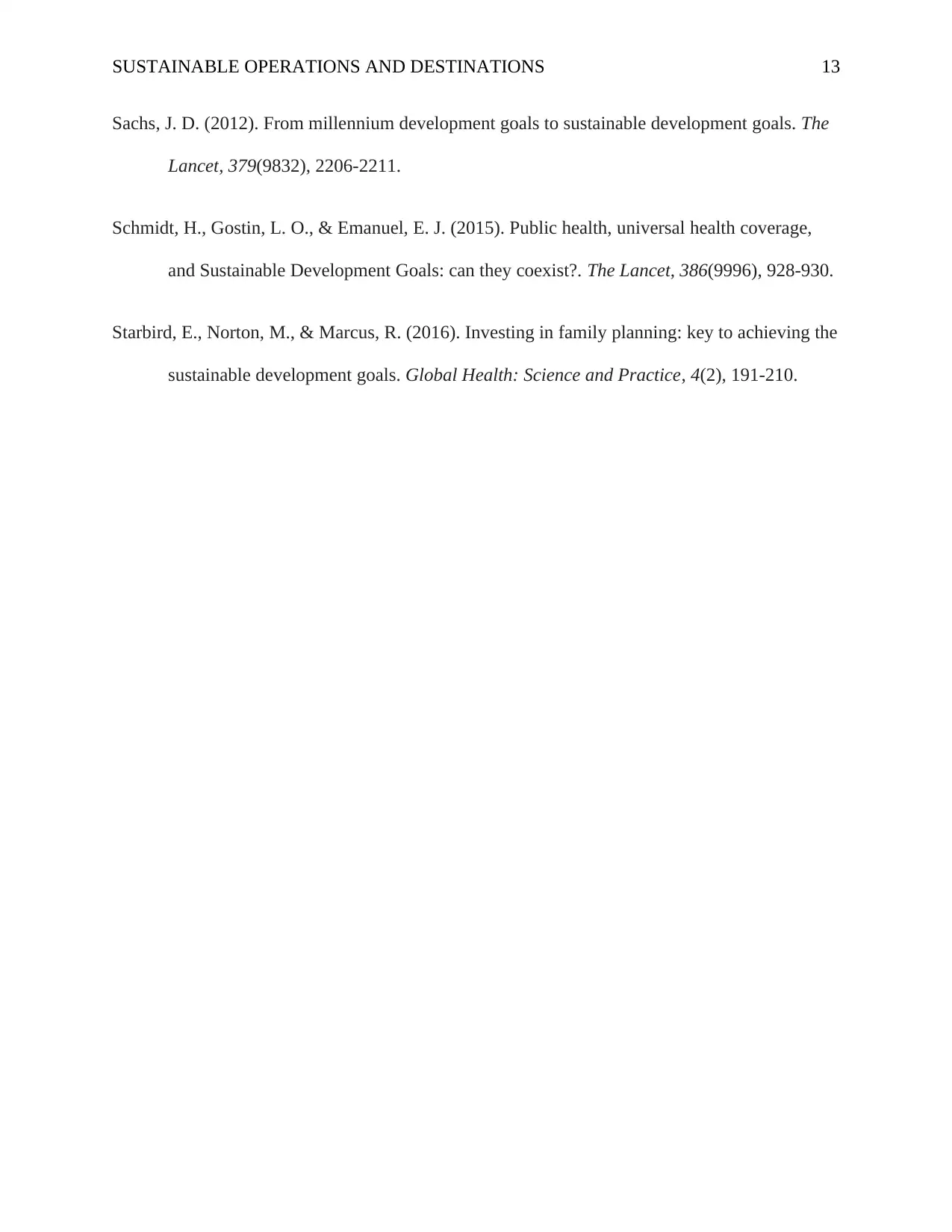
SUSTAINABLE OPERATIONS AND DESTINATIONS 13
Sachs, J. D. (2012). From millennium development goals to sustainable development goals. The
Lancet, 379(9832), 2206-2211.
Schmidt, H., Gostin, L. O., & Emanuel, E. J. (2015). Public health, universal health coverage,
and Sustainable Development Goals: can they coexist?. The Lancet, 386(9996), 928-930.
Starbird, E., Norton, M., & Marcus, R. (2016). Investing in family planning: key to achieving the
sustainable development goals. Global Health: Science and Practice, 4(2), 191-210.
Sachs, J. D. (2012). From millennium development goals to sustainable development goals. The
Lancet, 379(9832), 2206-2211.
Schmidt, H., Gostin, L. O., & Emanuel, E. J. (2015). Public health, universal health coverage,
and Sustainable Development Goals: can they coexist?. The Lancet, 386(9996), 928-930.
Starbird, E., Norton, M., & Marcus, R. (2016). Investing in family planning: key to achieving the
sustainable development goals. Global Health: Science and Practice, 4(2), 191-210.
1 out of 13
Related Documents
Your All-in-One AI-Powered Toolkit for Academic Success.
+13062052269
info@desklib.com
Available 24*7 on WhatsApp / Email
![[object Object]](/_next/static/media/star-bottom.7253800d.svg)
Unlock your academic potential
© 2024 | Zucol Services PVT LTD | All rights reserved.





